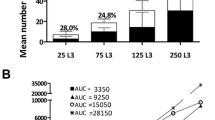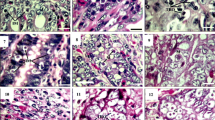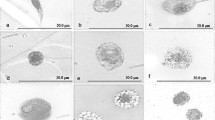Summary
A study was made, over a period of 12 weeks, of the distribution of a population of immune-adapted worms that had established themselves in the small intestine of rats as a result of exposure to a number of small daily challenge infections with the nematode Nippostrongylus brasiliensis.
Immature adapted worms were found to inhabit a greater length of the small intestine than immature primary infection worms. Mature worms, however, were restricted to the anterior two-fifths of the small intestine, the great majority of these infesting the region of the duodenum. The worms were not expelled from the intestine by an acute host-reaction, a large proportion of the worms still being present on the eighth week after the last larval challenge.
Evidence was obtained that these immune-adapted worms favoured the duodenal environment rather than the other regions of the intestine and that this attraction for the duodenum was not affected by the immune state of the host.
Similar content being viewed by others
References
Alphey, T. J. W.: Studies on the distribution and site location of Nippostrongylus brasiliensis within the small intestine of laboratory rats. Parasitology 61, 449–460 (1970).
Brambell, M. R.: Effects of age of infestation and of the immunity of the host on the distribution of Nippostrongylus brasiliensis in the small intestine of rats. Parasitology 53, 7 P. abstract (1963).
Brambell, M. R.: The distribution of a primary infestation of Nippostrongylus brasiliensis in the small intestine of laboratory rats. Parasitology 55, 313–324 (1965).
Jenkins, D. C.: Nippostrongylus brasiliensis: observations on the comparative immunogenicity of adult worms from primary and immune-adapted infections. Parasitology (1972) (in press).
Jenkins, D. C., Phillipson, R. F.: Increased establishment and longevity of Nippostrongylus brasiliensis in immune rats given repeated small infections. Int. J. Parasit. 2, 105–111 (1972a).
Jenkins, D. C., Phillipson, R. F.: Evidence that the nematode Nippostrongylus brasiliensis can adapt to an overcome the effects of host immunity. Int. J. Parasit. 2, 353–359 (1972b).
Keeling, J. E. D.: The effects of ultra-violet radiation on Nippostrongylus muris. 1. Irradiation of infective larvae: lethal and sub-lethal effects. Ann. trop. Med. Parasit. 54, 182–191 (1960).
Author information
Authors and Affiliations
Rights and permissions
About this article
Cite this article
Jenkins, D.C. Observations on the distribution of an immune-adapted population of Nippostrongylus brasiliensis within the small intestine of rats given repeated small challenge infections. Z. Parasitenk. 41, 73–82 (1973). https://doi.org/10.1007/BF00329632
Received:
Issue Date:
DOI: https://doi.org/10.1007/BF00329632




